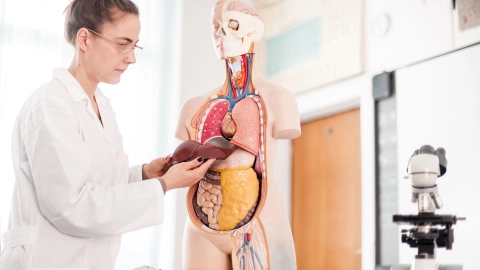Conditions Non-alcoholic fatty liver disease
ICD codes: K76 What are ICD codes?
More and more people in Europe are developing non-alcoholic fatty liver disease. It can be caused by an unhealthy diet and lack of physical exercise. This article explains more about what causes fatty liver disease, how it progresses and how it can be prevented.
At a glance
- Factors that increase the likelihood of non-alcoholic fatty liver disease include being overweight (obesity) and type 2 diabetes.
- Around 20 to 30% of adults in the industrialized countries have fatty liver disease. The figure rises to 80 to 90% for people who are obese.
- In most cases people do not realize they have fatty liver disease.
- Changes to diet and sport can be helpful for treating fatty liver disease.
Note: The information in this article cannot and should not replace a medical consultation and must not be used for self-diagnosis or treatment.

What is non-alcoholic fatty liver disease?
Fatty liver disease, also referred to as hepatic steatosis, occurs when there is a build-up of fat cells in the liver. People who are severely overweight (obese), undergo changes to their metabolism or have type 2 diabetes and high blood pressure have a higher risk of contracting non-alcoholic fatty liver disease.
A fatty liver is initially harmless but can be a pre-stage to a severe disease such as cirrhosis of the liver, a serious scarring of the liver.
What are the indications for non-alcoholic fatty liver disease?
Most people with fatty liver disease do not have any symptoms. Some report symptoms such as fatigue, thirst, bloating or insomnia. Upper abdominal pain may also occur.
At the advanced stage of the disease jaundice may set in, which can be recognized by yellowing of the skin, mucous membranes and the whites of the eyes.
What causes non-alcoholic fatty liver disease?
Non-alcoholic fatty liver disease can be caused by not enough exercise and a high-calorie diet.
Certain pre-existing conditions may also increase the likelihood of fatty liver disease, such as:
- being very overweight (obesity)
- type 2 diabetes
- metabolic disorders such as insulin resistance
- a metabolic syndrome: a combination of being severely overweight, sugar or lipid metabolism disorder and high blood pressure.
- dyslipidemia: a lipid metabolism disorder. It can be a hereditary condition but it can also be caused by an unhealthy lifestyle.
Taking certain medications or genetic factors can also cause fatty liver disease.
Video What causes fatty liver disease?
This video explains how fatty liver disease develops and what symptoms may occur.
This and other videos can also be found on YouTube
Watch nowThe privacy policy indicated there applies.
How common is non-alcoholic fatty liver disease?
Around 20 to 30% of adults in the industrialized countries have fatty liver disease. The figure rises to 80 to 90% for people who are severely overweight (obese).
3 to 10% of children whose weight is normal develop fatty liver disease, compared with 40 to 70% of children with obesity.
How does non-alcoholic fatty liver disease progress?
Fatty liver disease progresses slowly, with fat cells taking years to build up in the liver. It does not cause any symptoms at first and can be reversed if treated.
In around 30% of people fatty liver disease develops into steatohepatitis (an inflamed liver) that may become a chronic condition. The inflammation destroys cell tissue and causes scar tissue. Doctors refer to this condition as fibrosis.
This process can advance until cirrhosis of the liver develops. Cirrhosis is irreversible and can be life threatening if left untreated.
How can non-alcoholic fatty liver disease be prevented?
Fatty liver disease can be prevented by a healthy diet and regular physical activity.
The article Health through exercise provides more information on physical activities that are good for your health and the benefits of exercise.
How is non-alcoholic fatty liver disease diagnosed?
Blood tests can indicate fatty liver disease. Scans such as ultrasound can also be used to diagnose fatty liver disease.
A biopsy, where a sample of tissue is examined, may be considered if the results of the ultrasound scan are not definitive, or if doctors want to assess the stage of fatty liver disease. This tissue sample can be used, for example, to discover whether the liver is already inflamed.
The doctor may also need to rule out other causes of fatty liver disease to make sure it is non-alcoholic fatty liver disease. These could be:
- alcoholic fatty liver disease caused by high levels of alcohol consumption
- chronic hepatitis caused by infection with a hepatitis B or hepatitis C virus
- genetic conditions such as Wilson’s disease: this is a hereditary metabolic disorder where copper builds up in the liver and impairs organ function.
How is non-alcoholic fatty liver disease treated?
Abstaining from alcohol and losing weight can help people with fatty liver disease. Doctors also offer nutrition advice; a sports program is also often developed together with the patient.
Most people with fatty liver disease are advised to lose up to 7% of their body weight, or up to 10% if their liver is already inflamed. Drugs are sometimes used to support weight loss.
- DynaMed (Internet). Ipswich (MA). Nonalcoholic Fatty Liver Disease (NAFLD). EBSCO Information Services. 2018 (1995). Record No. T116915. Aufgerufen am 07.05.2021.
- Kudaravalli P, John S. Nonalcoholic Fatty Liver. [Updated 2020 May 28]. In: StatPearls [Internet]. Treasure Island (FL): StatPearls Publishing; 2021 Jan-. Aufgerufen am 07.05.2021.
- UpToDate (Internet). Epidemiology, clinical features, and diagnosis of nonalcoholic fatty liver disease in adults. Wolters Kluwer 2019. Aufgerufen am 07.05.2021.
- UpToDate (Internet). Management of nonalcoholic fatty liver disease in adults. Wolters Kluwer 2020. Aufgerufen am 07.05.2021.
In cooperation with the Institute for Quality and Efficiency in Health Care (Institut für Qualität und Wirtschaftlichkeit im Gesundheitswesen – IQWiG).
As at:



